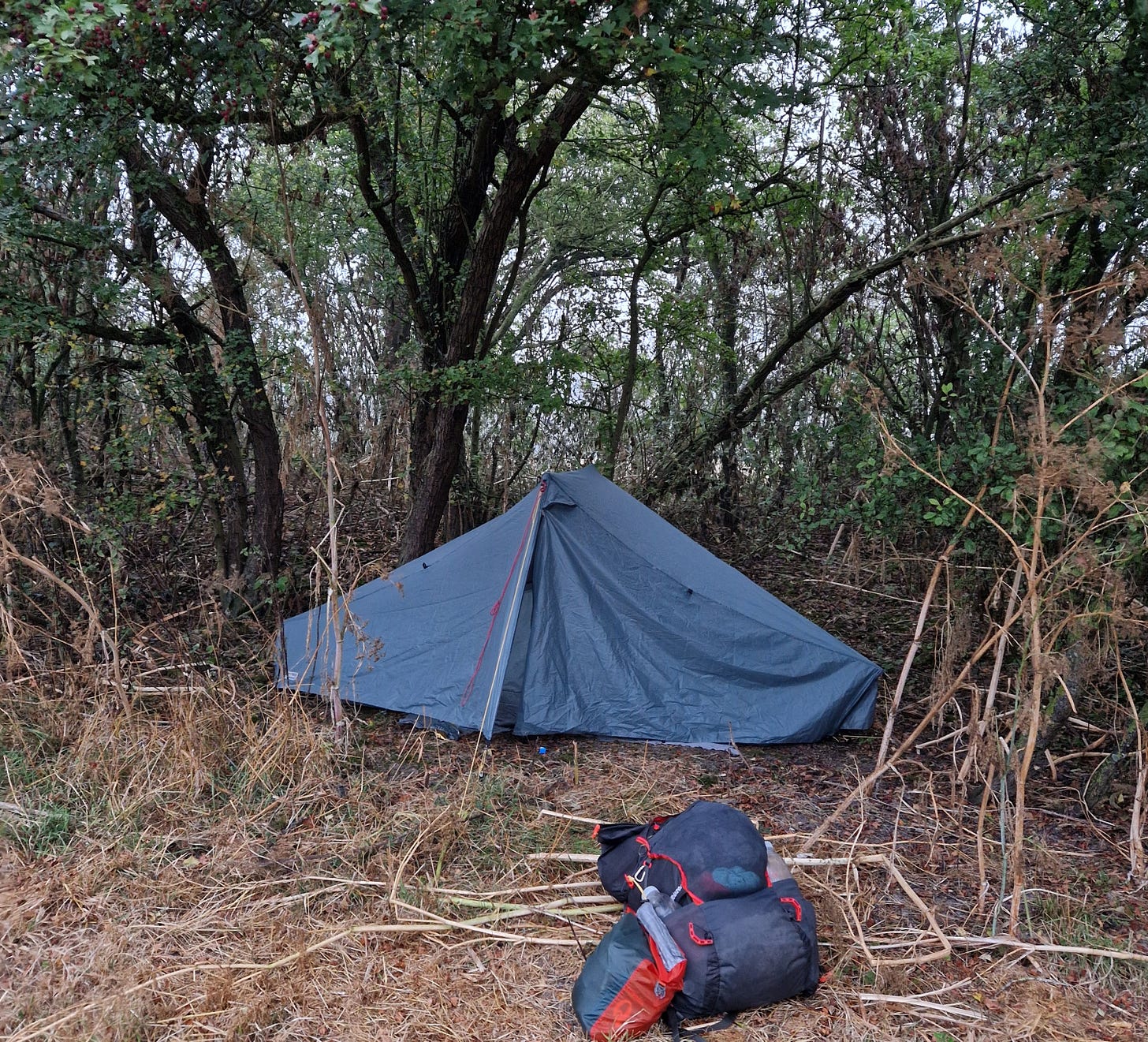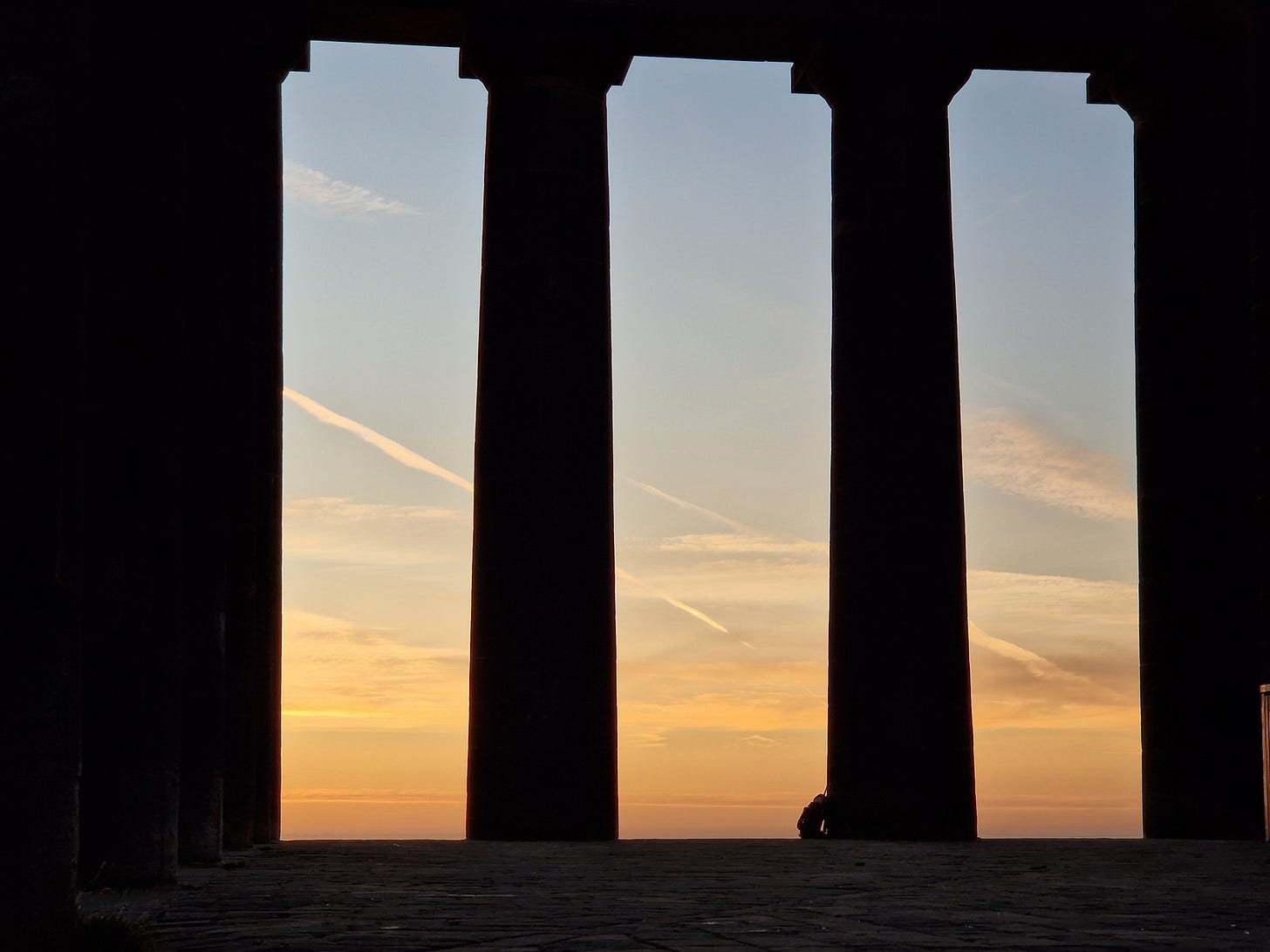"A Canny Walk Home" (Part 3: Wild Camping)
A Backpacking Adventure from Nottingham to Newcastle
To catch up on earlier chapters of this story, click on the links below:
Wild Camping from Nottingham to Newcastle
Despite my natural inclination for roaming, wild camping in England is not without risk.
Earlier this year, there was a video doing the rounds on social media taken by a farmer. A man, who looked more like a village parson than a rowdy litterbug, was camping on bare earth at the edge of the farmer’s field. He was a cyclist and was possibly travelling from Land’s End to John O’Groats. It was early morning, and in a fit of rage, the farmer drove his tractor up to the man and blasted him and his tent with manure from his muck-spreader whilst filming the whole thing on his mobile phone. The man retreated behind his tent in a futile effort to escape the drumming. “Well, ee won’t go in anyone else’s field wille!” the farmer victoriously announced into his phone.
At the other end of the rural income spectrum, entitled landowner Alexander Darwall, a hedge fund manager, is attempting to ban the longstanding right to wild camp on Dartmoor, the only place in England where it is technically permitted. I accuse him and his ilk of murdering the human spirit of adventure, opposing personal resilience, and creating a nation disconnected from the countryside. A modern-day Sheriff of Nottingham.
The fate of the sewage-soak cyclist was at the forefront of my mind when planning my route from Nottingham to Newcastle, and I purchased an inconspicuous dark green flysheet for my tent. And, although I didn’t know exactly where I would camp each night, I marked all the woods and copses along my route on a hand-drawn map with the aim of seeking maximum seclusion. If a hideout couldn’t be found, and I needed to camp near a farmhouse, I planned to ask permission first and offer payment. I would put politeness before principles. But in the event that eventuality didn’t arise.
The first two nights were like a dream, camping in Sherwood Forest, where there was an abundance of cover. But to avoid trouble, I steered clear of tourist sites, such as The Major Oak. The closest I got to Robin Hood was a sign marking the spot where, according to the ballads, he fought with Friar Tuck. Despite its ominous name, I slept like a log in Thieves Wood under a thicket of scrubby birch. There were no hoots of owls or clicks of crossbows; the faint hum of traffic was the only sound. On the second night in Clumber Park, after a cheeky swim in the lake, I pitched under a stand of tall pines that swayed above my tent like masts on a fleet of ships and whispered me to sleep.
Finding cover was more difficult in North Lincolnshire as the landscape became flat and treeless. The third night was the least successful when I slept in the hollow of a thorny hedge just off the towpath of the Chesterfield Canal. I spent an age clearing thorns from the ground so as not to puncture the base of my tent, only to discover the soil was so compacted I couldn’t push in the pegs. After bending a couple, I resorted to securing the guy ropes to flimsy branches. During the night, there was snuffling in the undergrowth, possibly badgers or a fox (something that would typically enchant me but, on this occasion, gave me the heebie-jeebies). Early the following morning, whilst eating breakfast in my tent and sheltering from the rain, I was confronted by two large dogs snarling and blocking my escape. I was defenceless. There was no way out to the rear because of the scrub, and I didn’t have my poles to protect me because they were propping up the tent. Finally, to my relief, a man who never materialised out of the gloom called them off.
On the fourth night, I was ensconced in the moors (or ‘wastes’) just south of Goole, where I saw a barn owl hunting at dusk, and I was slightly inebriated after locals insisted on buying me several pints in a nearby pub. The fifth was in a tiny copse on the banks of the River Ouse, overshadowed by the silhouette of Drax Power Station, where I stuffed plugs in my ears to silence the mechanical growl. The sixth, north of York, was in a secluded forestry plantation in the Howardian Hills, where a thousand lucid stars studded an obsidian sky, marking a dramatic change in weather conditions from humid and grey to clear and cold.
The most spectacular campsite of my trip was number seven, the only time I threw caution to the wind and camped near the path on the edge of the North Yorkshire Moors. I pitched my tent on a narrow strip of rough ground between the path and the edge of the escarpment. That evening, I watched a glorious sunset over the Vale of Mowbray and the North Yorkshire Dales. The sting in the tail was an unexpected frost, and I shivered through the night in my three-season sleeping bag. The following morning, my stove huffed and puffed, billowing clouds of steam that diffused light from the rising sun. There were few passers-by due to the time of year, and the only person to stop was, somewhat coincidentally, a local farmer on his mountain bike. We chatted about various rural issues, and he told me about the plague of pheasants released by nearby shooting estates overrunning his farm. Feeling apprehensive about my tent, pitched in plain sight, I explained I was walking from Nottingham to Newcastle and would be away by dawn. He wished me well and even forewarned me of ‘lampers’ out in the night shooting foxes in case I was alarmed by the bright lights. “But they won’t bother you here, lad”, he said. (I should make a viral video about the kindness of farmers I met on my trip to restore balance to the force).
My eighth night was spent just past the well-heeled village of Hutton Rudby in North Yorkshire on a bend of the River Leven near a sewage treatment works. After arriving late in the village to purchase supplies, I was fortunate to find this secluded spot after rejecting several other options, including the village green, asking locals if I could camp in their gardens, and a park bristling with “No Camping” signs.
After crossing the River Tees, my penultimate camp was just off a disused railway line in County Durham called the ‘Castle Eden Walkway’ in scrubby farmland between an impenetrable willow plantation, a felled wood, and a thicket of wind turbines — a strange, blasted landscape that would make a fine setting for a zombie movie.
As I neared the end of my trip, I became increasingly anxious about the final night, which would be the most urban, approaching Gateshead and Newcastle. The last conceivable place to camp before the finishing line was near the Penshaw Monument, a 19th-century folly built to resemble a Greek temple and a landmark for miles around. After a pint in ‘The Stables’, a charming village pub, I scouted around Herrington Country Park, just shy of the monument, and took my chances in a copse of young trees overlooking a hillock topped with boulders. It turned out to be a canny pitch, as I could also see the Penshaw Monument, illuminated with rainbow-coloured lights. To avoid a repeat of the dog incident, I decamped well before dawn and ate my breakfast sitting at the top of the hill on the monument, watching the sun rise over the North Sea. A memorable start to my final day.
In conclusion, by exercising an abundance of caution, stealth and politeness, I successfully wild camped ten times across England. No angry farmers. No muck-splattered clothes. No cow-trampled tent.
CONTINUE READING: PART 4










A bit easier in a bivvy bag. I slept in mine at very similar spot above Vale of York at the end of a long first day along the Coast to Coast (westbound). Never had any issues over dozens of lower level nights on long distance trails, field paths, coastal. (The shit scatterer was lucky not to get prosecuted for assault. Should have been.)
Well done. Sounds (mainly) fun. What do you do for water on a trip like this, when you can’t expect to find unpolluted mountain streams?